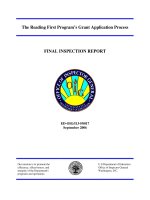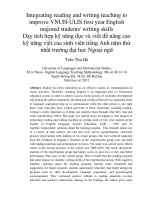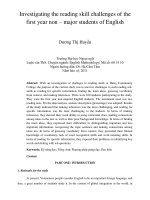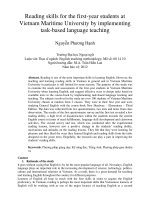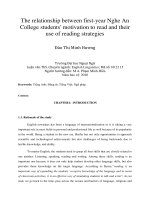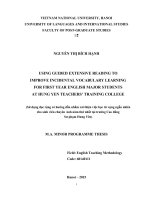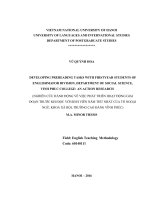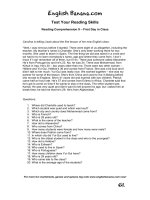2001 put reading first 60p
Bạn đang xem bản rút gọn của tài liệu. Xem và tải ngay bản đầy đủ của tài liệu tại đây (611.36 KB, 60 trang )
Put Reading First
Kindergarten Through Grade 3
The Research
Building Blocks
For Teaching
Children to Read
Third Edition
Edition
Third
The Research Building Blocks for Teaching Children to Read
Put Reading First
Kindergarten Through Grade 3
Writers:
Bonnie B. Armbruster, Ph.D., University of Illinois at Urbana-Champaign,
Fran Lehr, M.A., Lehr & Associates, Champaign, Illinois,
Jean Osborn, M.Ed., University of Illinois at Urbana-Champaign
Editor: C. Ralph Adler, RMC Research Corporation
Designer: Lisa T. Noonis, RMC Research Corporation
Contents
i Introduction
1 Phonemic Awareness Instruction
11 Phonics Instruction
19 Fluency Instruction
29 Vocabulary Instruction
41 Text Comprehension Instruction
This publication was developed by the Center for the Improvement of
Early Reading Achievement (CIERA) and was funded by the National
Institute for Literacy (NIFL) through the Educational Research and
Development Centers Program, PR/Award Number R305R70004, as
administered by the Office of Educational Research and Improvement
(OERI), U.S. Department of Education. However, the comments or
conclusions do not necessarily represent the positions or policies of
NIFL, OERI, or the U.S. Department of Education, and you should not
assume endorsement by the Federal Government.
The National Institute for Literacy
The National Institute for Literacy, an agency in the Federal government, is
authorized to help strengthen literacy across the lifespan. The Institute
works to provide national leadership on literacy issues, including the
improvement of reading instruction for children, youth, and adults by
sharing information on scientifically based research.
Sandra Baxter, Director
Lynn Reddy, Deputy Director
The Partnership for Reading
This document was published by The Partnership for Reading, a
collaborative effort of the National Institute for Literacy, the National
Institute of Child Health and Human Development, and the U.S. Department
of Education to make evidence-based reading research available to
educators, parents, policy-makers, and others with an interest in helping all
people learn to read well. The findings and conclusions in this publication
were drawn from the 2000 report of the National Reading Panel, Teaching
Children to Read: An Evidence-Based Assessment of the Scientific Research
Literature on Reading and Its Implications for Reading Instruction—Reports
of the Subgroups.
The writers and editors express their sincere thanks to:
• Isabel Beck, Douglas Carnine, Deborah Simmons, and Anne Sweet for
their careful reviews and suggestions
• Sandra Baxter and Andrew Hartman at the National Institute for Literacy
for their guidance and support
• The Subgroup Chairs of the National Reading Panel for their thoughtful
and thorough comments: Linnea Ehri, Michael L. Kamil, S.J. Samuels,
Timothy Shanahan, and Gloria Correro
• Susan Klaiber, Everett Barnes, and Douglas Hamman of RMC Research
Corporation for their conceptual and editorial contributions
• The teacher collaborative groups across the United States that provided
valuable feedback
Introduction
In today’s schools, too many children struggle with learning to read. As many teachers and
parents will attest, reading failure has exacted a tremendous long-term consequence for
children’s developing self-confidence and motivation to learn, as well as for their later school
performance.
While there are no easy answers or quick solutions for optimizing reading achievement,
an extensive knowledge base now exists to show us the skills children must learn in order to
read well. These skills provide the basis for sound curriculum decisions and instructional
approaches that can help prevent the predictable consequences of early reading failure.
The National Reading Panel (NRP) issued a report in 2000 that responded to a
Congressional mandate to help parents, teachers, and policymakers identify key skills and
methods central to reading achievement. The Panel was charged with reviewing research in
reading instruction (focusing on the critical years of kindergarten through third grade) and
identifying methods that consistently relate to reading success.
The Panel reviewed more than 100,000 studies. Through a carefully developed screening
procedure, Panel members examined research that met several important criteria:
•
the research had to address achievement of one or more skills in reading. Studies of
effective teaching were not included unless reading achievement was measured;
•
the research had to be generalizable to the larger population of students. Thus, case
studies with small numbers of children were excluded from the analysis;
•
the research needed to examine the effectiveness of an approach. This type of research
requires the comparison of different treatments, such as comparing the achievement of
students using guided repeated reading to another group of students not using that
strategy. This experimental research approach was necessary to understand whether
changes in achievement could be attributed to the treatment;
•
the research needed to be regarded as high quality. An article or book had to have been
reviewed by other scholars from the relevant field and judged to be sound and worthy of
publication. Therefore, discussions of studies reported in meetings or conferences without
a stringent peer review process were excluded from the analysis.
These criteria are not new in the world of educational research; they are often used as a
matter of course by researchers who set out to determine the effectiveness of any educational
program or approach. The National Reading Panel embraced the criteria in its review to bring
balance to a field in which decisions have often been made based more on ideology than
i
evidence. These criteria offer administrators, teachers, and parents a standard for evaluating
critical decisions about how children will be taught to read. In addition to identifying effective
practices, the work of the National Reading Panel challenges educators to consider the
evidence of effectiveness whenever they make decisions about the content and structure of
reading instruction programs. By operating on a “what works” basis, scientific evidence can
help build a foundation for instructional practice. Teachers can learn about and emphasize
methods and approaches that have worked well and caused reading improvement for large
numbers of children. Teachers can build their students’ skills efficiently and effectively, with
greater results than before. Most importantly, with targeted “what works“ instruction, the
incidence of reading success should increase dramatically.
This guide, designed by teachers for teachers, summarizes what researchers have
discovered about how to successfully teach children to read. It describes the findings of
the National Reading Panel Report and provides analysis and discussion in five areas of
reading instruction: phonemic awareness, phonics, fluency, vocabulary, and text
comprehension. Each section defines the skill, reviews the evidence from research, suggests
implications for classroom instruction, describes proven strategies for teaching reading skills,
and addresses frequently raised questions.
Our understanding of “what works“ in reading is dynamic and fluid, subject to ongoing
review and assessment through quality research. This guide begins the process of compiling
the findings from scientifically based research in reading instruction, a body of knowledge that
will continue to grow over time. We encourage all teachers to explore the research, open their
minds to changes in their instructional practice, and take up the challenge of helping all
children become successful readers.
ii
iii
iv
1
Phonemic
Awareness
Instruction
Phonemic awareness is the ability to notice, think about, and work with the individual sounds
in spoken words. Before children learn to read print, they need to become aware of how the
sounds in words work. They must understand that words are made up of speech sounds, or
phonemes.
Phonemes are the smallest parts of sound in a spoken word that make a difference in the
word’s meaning. For example, changing the first phoneme in the word hat from /h/ to /p/
changes the word from hat to pat, and so changes the meaning. (A letter between slash
marks shows the phoneme, or sound, that the letter represents, and not the name of the
letter. For example, the letter h represents the sound /h/.)
Children can show us that they have phonemic awareness in several ways, including:
•
recognizing which words in a set of words begin with the same sound (“Bell, bike, and
boy all have /b/ at the beginning.“);
•
isolating and saying the first or last sound in a word (“The beginning sound of dog is
/d/.“ “The ending sound of sit is /t/.“);
•
combining, or blending the separate sounds in a word to say the word (“/m/, /a/, /p/—
map.“);
•
breaking, or segmenting a word into its separate sounds (“Up—/u/, /p/.“).
Children who have phonemic awareness skills are likely to have an easier time learning to
read and spell than children who have few or none of these skills.
Although phonemic awareness is a widely used term in reading, it is often misunderstood.
One misunderstanding is that phonemic awareness and phonics are the same thing. Phonemic
awareness is not phonics. Phonemic awareness is the understanding that the sounds of
spoken language work together to make words. Phonics is the understanding that there is a
predictable relationship between phonemes and graphemes, the letters that represent those
sounds in written language. If children are to benefit from phonics instruction, they need
phonemic awareness.
The reason is obvious: children who cannot hear and work with the phonemes of spoken
words will have a difficult time learning how to relate these phonemes to the graphemes
when they see them in written words.
1
Another misunderstanding about phonemic awareness is that it means the same as
phonological awareness. The two names are not interchangeable. Phonemic awareness is a
subcategory of phonological awareness. The focus of phonemic awareness is narrow—
identifying and manipulating the individual sounds in words. The focus of phonological
awareness is much broader. It includes identifying and manipulating larger parts of spoken
language, such as words, syllables, and onsets and rimes—as well as phonemes. It also
encompasses awareness of other aspects of sound, such as rhyming, alliteration, and
intonation.
Children can show us that they have phonological awareness in several ways, including:
•
identifying and making oral rhymes;
“The pig has a (wig).“
“Pat the (cat).“
“The sun is (fun).“
•
identifying and working with syllables in spoken words;
“I can clap the parts in my name: An-drew.“
•
identifying and working with onsets and rimes in spoken syllables or one-syllable words;
“The first part of sip is s-.“
“The last part of win is -in.“
•
identifying and working with individual phonemes in spoken words.
“The first sound in sun is /s/.“
PHONOLOGICAL AWARENESS
Phonemic awareness is only one type of phonological awareness.
Broader phonological awareness
• Identifying and making oral rhymes
• Identifying and working with syllables in spoken words
Narrower phonological awareness
• Identifying and working with onsets and rimes in spoken syllables
• Identifying and working with individual phonemes in words spoken
(phonemic awareness)
2
THE LANGUAGE OF LITERACY
Here are some definitions of terms used frequently in reading instruction.
Phoneme
A phoneme is the smallest part of spoken language that makes a difference in
the meaning of words. English has about 41 phonemes. A few words, such as a
or oh, have only one phoneme. Most words, however, have more than one
phoneme: The word if has two phonemes (/i/ /f/); check has three phonemes
(/ch/ /e/ /k/), and stop has four phonemes (/s/ /t/ /o/ /p/). Sometimes one
phoneme is represented by more than one letter.
Grapheme
A grapheme is the smallest part of written language that represents a
phoneme in the spelling of a word. A grapheme may be just one letter, such as b,
d, f, p, s; or several letters, such as ch, sh, th, -ck, ea, -igh.
Phonics
Phonics is the understanding that there is a predictable relationship between
phonemes (the sounds of spoken language) and graphemes (the letters and
spellings that represent those sounds in written language).
Phonemic awareness
Phonemic awareness is the ability to hear, identify, and manipulate the
individual sounds—phonemes—in spoken words.
Phonological awareness
Phonological awareness is a broad term that includes phonemic awareness. In
addition to phonemes, phonological awareness activities can involve work with
rhymes, words, syllables, and onsets and rimes.
Syllable
A syllable is a word part that contains a vowel or, in spoken language, a vowel
sound (e-vent; news-pa-per; ver-y).
Onset and rime
Onsets and rimes are parts of spoken language that are smaller than syllables
but larger than phonemes. An onset is the initial consonant(s) sound of a syllable
(the onset of bag is b-; of swim, sw-). A rime is the part of a syllable that
contains the vowel and all that follows it (the rime of bag is -ag; of swim, -im).
3
What does scientifically based research
tell us about phonemic awareness instruction?
Key findings from the scientific research on phonemic awareness instruction provide the
following conclusions of particular interest and value to classroom teachers:
Phonemic awareness can be taught and learned.
Effective phonemic awareness instruction teaches children to notice, think about, and work
with (manipulate) sounds in spoken language. Teachers use many activities to build phonemic
awareness, including:
•
Phoneme isolation
Children recognize individual sounds in a word.
Teacher: “What is the first sound in van?”
Children: “The first sound in van is /v/.”
•
Phoneme identity
Children recognize the same sounds in different words.
Teacher: “What sound is the same in fix, fall, and fun?”
Children: “The first sound, /f/, is the same.”
•
Phoneme categorization
Children recognize the word in a set of three or four words that has the “odd“ sound.
Teacher: “Which word doesn’t belong? Bus, bun, rug.”
Children: “Rug does not belong. It doesn’t begin with /b/.”
•
Phoneme blending
Children listen to a sequence of separately spoken phonemes, and then combine the
phonemes to form a word. Then they write and read the word.
Teacher: “What word is /b/ /i/ /g/?”
Children: “/b/ /i/ /g/ is big.”
Teacher: “Now let’s write the sounds in big: /b/, write b; /i/, write i; /g/, write g.”
Teacher: (Writes big on the board.) “Now we’re going to read the word big.”
•
Phoneme segmentation
Children break a word into its separate sounds, saying each sound as they tap out or
count it. Then they write and read the word.
Teacher: “How many sounds are in grab?”
Children: “/g/ /r/ /a/ /b/. Four sounds.”
Teacher: “Now let’s write the sounds in grab: /g/, write g; /r/, write r; /a/, write a; /b/,
write b.”
Teacher: (Writes grab on the board.) “Now we’re going to read the word grab.”
4
•
Phoneme deletion
Children recognize the word that remains when a phoneme is removed from another
word.
Teacher: “What is smile without the /s/?”
Children: “Smile without the /s/ is mile.”
•
Phoneme addition
Children make a new word by adding a phoneme to an existing word.
Teacher: “What word do you have if you add /s/ to the beginning of park?”
Children: “Spark.”
•
Phoneme substitution
Children substitute one phoneme for another to make a new word.
Teacher: “The word is bug. Change /g/ to /n/. What’s the new word?”
Children: “Bun.”
Phonemic awareness instruction helps children learn to read.
Phonemic awareness instruction improves children’s ability to read words. It also improves
their reading comprehension. Phonemic awareness instruction aids reading comprehension
primarily through its influence on word reading. For children to understand what they read,
they must be able to read words rapidly and accurately. Rapid and accurate word reading
frees children to focus their attention on the meaning of what they read. Of course, many
other things, including the size of children’s vocabulary and their world experiences, contribute
to reading comprehension.
Phonemic awareness instruction helps children learn to spell.
Teaching phonemic awareness, particularly how to segment words into phonemes, helps
children learn to spell. The explanation for this may be that children who have phonemic
awareness understand that sounds and letters are related in a predictable way. Thus, they are
able to relate the sounds to letters as they spell words.
Phonemic awareness instruction is most effective when children are
taught to manipulate phonemes by using the letters of the alphabet.
Phonemic awareness instruction makes a stronger contribution to the improvement of reading
and spelling when children are taught to use letters as they manipulate phonemes than when
instruction is limited to phonemes alone. Teaching sounds along with the letters of the
alphabet is important because it helps children to see how phonemic awareness relates to
their reading and writing. Learning to blend phonemes with letters helps children read words.
Learning to segment sounds with letters helps them spell words.
If children do not know letter names and shapes, they need to be taught them along with
phonemic awareness.
5
Relating sounds to letters is, of course, the heart of phonics instruction, which is the
subject of the next section of this booklet.
Phonemic awareness instruction is most effective when it focuses on
only one or two types of phoneme manipulation, rather than several
types.
Children who receive instruction that focuses on one or two types of phoneme manipulation
make greater gains in reading and spelling than do children who are taught three or more
types of manipulation.
One possible explanation for this is that children who are taught many different ways to
manipulate phonemes may become confused about which type to apply. Another explanation
is that teaching many types of manipulations does not leave enough time to teach any one
type thoroughly. A third explanation is that instruction that includes several types of
manipulations may result in teaching children more difficult manipulations before they
acquire skills in the easier ones.
SOME COMMON PHONEMIC AWARENESS TERMS
Phoneme manipulation
When children work with phonemes in words, they are manipulating the phonemes. Types
of phoneme manipulation include blending phonemes to make words, segmenting words
into phonemes, deleting phonemes from words, adding phonemes to words, or substituting
one phoneme for another to make a new word.
Blending
When children combine individual phonemes to form words, they are blending the
phonemes. They also are blending when they combine onsets and rimes to make syllables
and combine syllables to make words.
Segmenting (segmentation)
When children break words into their individual phonemes, they are segmenting the words.
They are also segmenting when they break words into syllables and syllables into onsets
and rimes.
6
Questions you may have about
phonemic awareness instruction
Which activities will help my students acquire phonemic awareness?
Your instruction to increase children’s phonemic awareness can include various activities in
blending and segmenting words. Clearly, however, you should provide your students with
instruction that is appropriate for their level of literacy development. If you teach younger
children or less able, older readers, your instruction should begin with easier activities, such
as having children identify and categorize the first phonemes in words. When the children can
do these activities, move on to more difficult ones.
Which methods of phonemic awareness instruction will have the
greatest impact on my students’ learning to read?
You can use a variety of teaching methods that contribute to children’s success in learning to
read. However, teaching one or two types of phoneme manipulation—specifically blending
and segmenting phonemes in words—is likely to produce greater benefits to your students’
reading than teaching several types of manipulation.
Teaching your students to manipulate phonemes along with letters can also contribute to
their reading success.
Your instruction should also be explicit about the connection between phonemic
awareness and reading. For example:
Teacher: “Listen: I’m going to say the sounds in the word jam—/j/ /a/ /m/.
What is the word?”
Children: “Jam.”
Teacher: “You say the sounds in the word jam.”
Children: “/j/ /a/ /m/.”
Teacher: “Now let’s write the sounds in jam: /j/, write j; /a/, write a; /m/, write m.”
Teacher: (Writes jam on the board.) “Now we’re going to read the word jam.”
Which of my students will benefit from phonemic awareness
instruction?
Phonemic awareness instruction can help essentially all of your students learn to read,
including preschoolers, kindergartners, first graders who are just starting to read, and older,
less able readers.
Phonemic awareness instruction can help most of your students learn to spell. Instruction
can be effective with preschoolers, kindergartners, and first graders. It can help children from
all economic levels.
7
How much time should I spend on phonemic awareness instruction?
You do not need to devote a lot of class time to phonemic awareness instruction. Over the
school year, your entire phonemic awareness program should take no more than 20 hours.
Your students will differ in their phonemic awareness. Some will need more instruction
than others. The best approach is to assess students’ phonemic awareness before you begin
instruction. Assessment will let you know which students do and do not need the instruction,
which students should be taught the easier types of phoneme manipulation (such as
identifying initial sounds in words), and which should receive instruction in more advanced
types (such as segmenting, blending, deletion/addition, and substitution).
Should I teach phonemic awareness to individual students, to small
groups, or to the whole class?
In general, small-group instruction is more effective in helping your students acquire phonemic
awareness and learn to read. Small-group instruction may be more effective than individual or
whole-group instruction because children often benefit from listening to their classmates
respond and receive feedback from the teacher.
Do we know enough about the effectiveness of phonemic awareness
instruction for me to implement it in my classroom?
Yes. Bear in mind, however, that phonemic awareness instruction is not a complete reading
program; it cannot guarantee the reading and writing success of your students. Adding wellthought-out phonemic awareness instruction to a beginning reading program or to a remedial
reading program is very likely to help your students learn to read and spell. Whether these
benefits are lasting, however, will depend on the comprehensiveness and effectiveness of the
entire literacy curriculum.
8
SUMMING UP
Phonemic awareness is
• the ability to hear, identify, and manipulate individual sounds—phonemes—
in spoken words.
Phonemic awareness is important because
• it improves children’s word reading and reading comprehension.
• it helps children learn to spell.
Phonemic awareness can be developed through a number of
activities, including asking children to
• identify phonemes,
• categorize phonemes,
• blend phonemes to form words,
• segment words into phonemes,
• delete or add phonemes to form new words, and
• substitute phenomes to make new words.
Phonemic awareness instruction is most effective
• when children are taught to manipulate phonemes by using the letters of
the alphabet.
• when instruction focuses on only one or two rather than several types of
phoneme manipulation.
9
2
Phonics
Instruction
Phonics instruction teaches children the relationships between the letters (graphemes) of
written language and the individual sounds (phonemes) of spoken language. It teaches
children to use these relationships to read and write words. Teachers of reading and
publishers of programs of beginning reading instruction sometimes use different labels to
describe these relationships, including the following:
•
graphophonemic relationships
•
letter-sound associations
•
letter-sound correspondences
•
sound-symbol correspondences
•
sound-spellings
Regardless of the label, the goal of phonics instruction is to help children learn and use
the alphabetic principle—the understanding that there are systematic and predictable
relationships between written letters and spoken sounds. Knowing these relationships will
help children recognize familiar words accurately and automatically, and “decode“ new
words. In short, knowledge of the alphabetic principle contributes greatly to children’s ability
to read words both in isolation and in connected text.
Critics of phonics instruction argue that English spellings are too irregular for
phonics instruction to really help children learn to read words. The point is, however,
that phonics instruction teaches children a system for remembering how to read words.
Once children learn, for example, that phone is spelled this way rather than foan, their
memory helps them to read, spell, and recognize the word instantly and more accurately
than they could read foan. The same process is true for all irregularly spelled words. Most
of these words contain some regular letter-sound relationships that can help children
remember how to read them.
In summary, the alphabetic system is a mnemonic device that supports our memory for
specific words.
11
What does scientifically based research
tell us about phonics instruction?
Key findings from the scientific research on phonics instruction include the following
conclusions of particular interest and value to classroom teachers.
Systematic and explicit phonics instruction is more effective than
non-systematic or no phonics instruction.
Systematic and explicit phonics instruction makes a bigger contribution to children’s growth in
reading than instruction that provides non-systematic or no phonics instruction.
How do systematic programs of phonics instruction differ from non-systematic programs?
The hallmark of programs of systematic phonics instruction is the direct teaching of a set of
letter-sound relationships in a clearly defined sequence. The set includes the major sound/
spelling relationships of both consonants and vowels.
The programs also provide materials that give children substantial practice in applying
knowledge of these relationships as they read and write. These materials include books or
stories that contain a large number of words that children can decode by using the lettersound relationships they have learned and are learning. The programs also might provide
children with opportunities to spell words and to write their own stories with the letter-sound
relationships they are learning.
APPROACHES TO PHONICS INSTRUCTION
Most teachers are acquainted with several approaches to phonics instruction, including
those listed below. The distinctions between approaches are not absolute, and some
programs of instruction combine approaches.
Synthetic phonics Children learn how to convert letters or letter combinations into
sounds, and then how to blend the sounds together to form recognizable words.
Analytic phonics Children learn to analyze letter-sound relationships in previously learned
words. They do not pronounce sounds in isolation.
Analogy-based phonics Children learn to use parts of word families they know to identify
words they don’t know that have similar parts.
Phonics through spelling Children learn to segment words into phonemes and to make
words by writing letters for phonemes.
Embedded phonics Children are taught letter-sound relationships during the reading of
connected text. (Since children encounter different letter-sound relationships as they read,
this approach is not systematic or explicit.)
Onset-rime phonics instruction Children learn to identify the sound of the letter or
letters before the first vowel (the onset) in a one-syllable word and the sound of the
remaining part of the word (the rime).
12
Systematic and explicit phonics instruction significantly improves
kindergarten and first-grade children’s word recognition and spelling.
Systematic phonics instruction produces the greatest impact on children’s reading
achievement when it begins in kindergarten or first grade.
Both kindergarten and first-grade children who receive systematic phonics instruction are
better at reading and spelling words than kindergarten and first-grade children who do not
receive systematic instruction.
Systematic and explicit phonics instruction significantly improves
children’s reading comprehension.
Systematic phonics instruction results in better growth in children’s ability to comprehend
what they read than non-systematic or no phonics instruction. This is not surprising because
the ability to read the words in a text accurately and quickly is highly related to successful
reading comprehension.
Systematic and explicit phonics instruction is effective for children
from various social and economic levels.
Systematic phonics instruction is beneficial to children regardless of their socioeconomic
status. It helps children from various backgrounds make greater gains in reading than nonsystematic instruction or no phonics instruction.
Systematic and explicit phonics instruction is particularly beneficial
for children who are having difficulty learning to read and who are at
risk for developing future reading problems.
Systematic phonics instruction is significantly more effective than non-systematic or no
phonics instruction in helping to prevent reading difficulties among at-risk students and in
helping children overcome reading difficulties.
Systematic and explicit phonics instruction is most effective when
introduced early.
Phonics instruction is most effective when it begins in kindergarten or first grade. To be
effective with young learners, systematic instruction must be designed appropriately and
taught carefully. It should include teaching letter shapes and names, phonemic awareness,
and all major letter-sound relationships. It should ensure that all children learn these skills.
As instruction proceeds, children should be taught to use this knowledge to read and
write words.
13
Phonics instruction is not an entire reading program for beginning
readers.
Along with phonics instruction, young children should be solidifying their knowledge of the
alphabet, engaging in phonemic awareness activities, and listening to stories and
informational texts read aloud to them. They also should be reading texts (both out loud and
silently), and writing letters, words, messages, and stories.
PROGRAMS OF SYSTEMATIC AND EXPLICIT PHONICS INSTRUCTION
Systematic and explicit phonics instruction provides practice with letter-sound
relationships in a predetermined sequence. Children learn to use these relationships to
decode words that contain them.
Questions you may have about phonics instruction
Do we know enough about the effectiveness of systematic and
explicit phonics instruction for me to implement it in my classroom?
Yes. Many teachers are teaching phonics systematically and explicitly and have been doing so
for years. Their results, along with the findings of three decades of research, confirm the
importance and effectiveness of systematic phonics instruction, particularly in kindergarten
and first- and second-grade classrooms.
How can I tell if a phonics program is systematic and explicit?
A program of systematic phonics instruction clearly identifies a carefully selected and useful
set of letter-sound relationships and then organizes the introduction of these relationships into
a logical instructional sequence. The instructional sequence may include the relationships
between the sounds associated with single letters (for example, the sound /m/ with the letter
m), as well as with larger units of written language (for example, letter combinations such as
th or ing or spelling patterns such as ea or ie). Furthermore, a systematic program of
instruction provides children with ample opportunities to practice the relationships they are
learning.
What do non-systematic programs of phonics instruction look like?
Programs of phonics instruction that are not systematic do not teach consonant and vowel
letter-sound relationships in a prescribed sequence. Rather, they encourage informal phonics
instruction based on the teacher’s perceptions of what students need to learn and when they
need to learn it.
Non-systematic instruction often neglects vowels, even though knowing vowel lettersound relationships is a crucial part of knowing the alphabetic system. Non-systematic
14
programs of phonics instruction do not provide practice materials that offer children the
opportunity to apply what they are learning about letter-sound relationships. The reading
materials these programs do provide for children are selected according to other criteria, such
as their interest to children or their literary value.
GENERAL GUIDELINES:
EVALUATING PROGRAMS OF PHONICS INSTRUCTION
Effective programs offer phonics instruction that
• helps teachers explicitly and systematically instruct students in how to relate letters and
sounds, how to break spoken words into sounds, and how to blend sounds to form words;
• helps students understand why they are learning the relationships between letters and
sounds;
• helps students apply their knowledge of phonics as they read words, sentences, and text;
• helps students apply what they learn about sounds and letters to their own writing;
• can be adapted to the needs of individual students, based on assessment;
• includes alphabetic knowledge, phonemic awareness, vocabulary development, and the
reading of text, as well as systematic phonics instruction.
What else should I look for in programs of phonics instruction?
Programs should acknowledge that systematic phonics instruction is a means to an end.
Some phonics programs focus primarily on teaching children a large number of letter-sound
relationships. These programs often do not allot enough instructional time to help children
learn how to put this knowledge to use in reading actual words, sentences, and texts.
Although children need to be taught the major consonant and vowel letter-sound
relationships, they also need ample reading and writing activities that allow them to
practice using this knowledge.
What kinds of reading practice materials should I look for?
Usually, practice materials are in the form of short books or stories that contain words
that provide children with practice in using the specific letter-sound relationships they are
learning. Most programs of systematic phonics instruction also include materials for use in
practicing writing. For example, children might have activity sheets on which they write the
letters and letter combinations they are learning, and then combine these into words,
sentences, messages, and their own stories.
15

